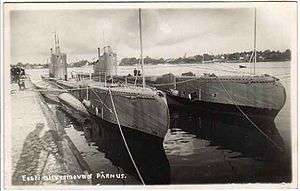Kalev-class submarine
 Kalev and Lembit | |
| Class overview | |
|---|---|
| Name: | Kalev class |
| Builders: | Vickers Armstrong |
| Operators: | |
| In commission: | 1936 - 1979 |
| Completed: | 2 |
| Lost: | 1 |
| Preserved: | 1 |
| General characteristics | |
| Type: | Submarine |
| Tonnage: | 570 (in its current condition) |
| Displacement: |
|
| Length: | 59.5 m (195 ft 3 in) |
| Beam: | 7.5 m (24 ft 7 in) |
| Draught: | 3.6 m (11 ft 10 in) |
| Speed: |
|
| Complement: | 4 officers + 28 enlisted |
| Armament: |
|
The Kalev class consisted of two mine laying submarines built for the Estonian Navy.
Development history
The newly independent Republic of Estonia followed the Finnish naval armament program and the common top secret defence cooperation in acquiring submarines. Unlike the German-designed Finnish subs, Estonia opted for British-built submarines. Both boats of the class Kalev and Lembit were built by Vickers-Armstrong at Barrow-in-Furness, in the United Kingdom.[1]
Service history
The two subs were ordered in 1936 and delivered in 1939. After the Soviet annexation of Estonia in 1940 the Estonian Navy was integrated into the Soviet Baltic Fleet. The Kalev-class submarines were commissioned into the Soviet Navy on September 18, 1940. Kalev was sunk outside Hanko, Finland in 1941, but Lembit continued a successful campaign against Swedish iron ore transports to Germany. Lembit was decommissioned in 1979. She is now preserved as a museum ship at the Estonian Maritime Museum Lennusadam (Seaplane harbour/Hydroplane port), Tallinn.
As a museum exhibit
Main article: EML Lembit.
See also
References
External links
- Submarine Lembit - Estonian Maritime Museum
- Kalev-class submarine (Kalev or Lembit)
- The Vickers Photographic Archive (search for Kalev)
- Lembit Submarine - Tallinn
- Allied Warships - Kalev class
| Wikimedia Commons has media related to Kalev class submarines. |